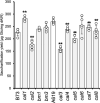A large-scale forward genetic screen for maize mutants with altered lignocellulosic properties
- PMID: 36959947
- PMCID: PMC10028098
- DOI: 10.3389/fpls.2023.1099009
A large-scale forward genetic screen for maize mutants with altered lignocellulosic properties
Abstract
The development of efficient pipelines for the bioconversion of grass lignocellulosic feedstocks is challenging due to the limited understanding of the molecular mechanisms controlling the synthesis, deposition, and degradation of the varying polymers unique to grass cell walls. Here, we describe a large-scale forward genetic approach resulting in the identification of a collection of chemically mutagenized maize mutants with diverse alterations in their cell wall attributes such as crystalline cellulose content or hemicellulose composition. Saccharification yield, i.e. the amount of lignocellulosic glucose (Glc) released by means of enzymatic hydrolysis, is increased in two of the mutants and decreased in the remaining six. These mutants, termed candy-leaf (cal), show no obvious plant growth or developmental defects despite associated differences in their lignocellulosic composition. The identified cal mutants are a valuable tool not only to understand recalcitrance of grass lignocellulosics to enzymatic deconstruction but also to decipher grass-specific aspects of cell wall biology once the genetic basis, i.e. the location of the mutation, has been identified.
Keywords: cell wall; lignocellolusic biomass; maize; mutant; saccharification.
Copyright © 2023 Wang, Robertz, Seven, Kraemer, Kuhn, Liu, Lunde, Pauly and Ramírez.
Conflict of interest statement
The authors declare that the research was conducted in the absence of any commercial or financial relationships that could be construed as a potential conflict of interest.
Figures


Similar articles
-
Engineering grass biomass for sustainable and enhanced bioethanol production.Planta. 2019 Aug;250(2):395-412. doi: 10.1007/s00425-019-03218-y. Epub 2019 Jun 24. Planta. 2019. PMID: 31236698 Review.
-
Breeding for improved digestibility and processing of lignocellulosic biomass in Zea mays.Front Plant Sci. 2024 Jul 26;15:1419796. doi: 10.3389/fpls.2024.1419796. eCollection 2024. Front Plant Sci. 2024. PMID: 39129761 Free PMC article. Review.
-
Tracking of enzymatic biomass deconstruction by fungal secretomes highlights markers of lignocellulose recalcitrance.Biotechnol Biofuels. 2019 Apr 1;12:76. doi: 10.1186/s13068-019-1417-8. eCollection 2019. Biotechnol Biofuels. 2019. PMID: 30976326 Free PMC article.
-
Genome-Wide Association Study for Major Biofuel Traits in Sorghum Using Minicore Collection.Protein Pept Lett. 2021;28(8):909-928. doi: 10.2174/0929866528666210215141243. Protein Pept Lett. 2021. PMID: 33588716
-
Analysis of pectin mutants and natural accessions of Arabidopsis highlights the impact of de-methyl-esterified homogalacturonan on tissue saccharification.Biotechnol Biofuels. 2013 Nov 18;6(1):163. doi: 10.1186/1754-6834-6-163. Biotechnol Biofuels. 2013. PMID: 24245704 Free PMC article.
Cited by
-
Studying microbial triglyceride production from corn stover saccharides unveils insights into the galactose metabolism of Ustilago maydis.Microb Cell Fact. 2024 Jul 20;23(1):204. doi: 10.1186/s12934-024-02483-1. Microb Cell Fact. 2024. PMID: 39033104 Free PMC article.
-
Monitoring corn stover processing by the fungus Ustilago maydis.Bioresour Bioprocess. 2024 Sep 14;11(1):87. doi: 10.1186/s40643-024-00802-3. Bioresour Bioprocess. 2024. PMID: 39276241 Free PMC article.
-
Sampling-free investigation of microbial carbon source preferences on renewable feedstocks via online monitoring of oxygen transfer rate.Bioprocess Biosyst Eng. 2025 Mar;48(3):413-425. doi: 10.1007/s00449-024-03117-x. Epub 2024 Dec 16. Bioprocess Biosyst Eng. 2025. PMID: 39680140 Free PMC article.
References
-
- Barrière Y., Chavigneau H., Delaunay S., Courtial A., Bosio M., Lassagne H., et al. . (2013). Different mutations in the ZmCAD2 gene underlie the maize brown-midrib1 (bm1) phenotype with similar effects on lignin characteristics and have potential interest for bioenergy production. Maydica 58, 6–20.
-
- Burton R. A., Collins H. M., Kibble N. A., Smith J. A., Shirley N. J., Jobling S. A., et al. . (2011). Over-expression of specific HvCslF cellulose synthase-like genes in transgenic barley increases the levels of cell wall (1,3;1,4)-β-d-glucans and alters their fine structure. Plant Biotechnol. J. 9 (2), 117–135. doi: 10.1111/j.1467-7652.2010.00532.x - DOI - PubMed
LinkOut - more resources
Full Text Sources

